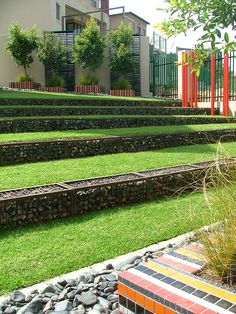gabion-wall-stones-rocks
Gabion walls make a rock solid garden statement
Phyllis, April
2015
Ancient armies fought over them and Leonardo da Vinci used them in a castle – now gabion walls are rocking gardens across the country.
The word gabion comes from the Italian “gabbione” meaning big cage – and that’s exactly what they are – big wire cages filled with rocks. They were originally built by armies to shield artillery crews in medieval times and Leonardo da Vinci designed one for the base of a castle in the 1400s.

Engineering marvels
Gabions were used as retaining walls in large engineering projects such a motorways and dams for decades before wealthy homeowners started installing them as imposing (and expensive) boundary fences and landscaping statements. However more and more “mere mortals” are including gabions in their gardens. And why wouldn’t they? These things were designed to withstand armies, are (mostly) made from natural materials, never need to be painted and certainly won’t rot. The down side? Well apart from the fact that changing your mind about the location after it’s in place would mean an awful lot of work, there isn’t one.Moving with the times
Gabions have evolved far beyond their original purpose as a large shield or wall. Nowadays they’re a tour de force as sculptures, fire pits, planters, seats and water features. Gabion retaining walls are an obvious solution for sloping sites and anywhere drainage is important. Oh, and you even see them as low entry walls either side of driveway entries. As for the traditional filling of large stones, while still popular, people are adding their own artistic variations, using clay pipes, bottles, large chunks of coloured glass, roof tiles, logs and even small tyres. Different materials or colours can be layered to create patterns and some are even surrounded by metal or timber frames or small contents contained within the mesh by glass or Perspex panels. Cost-wise, there are landscapers who can install them for you, or you can buy the baskets and fill them yourself. The only downside to the DIY option is if you want to build something above chest height. The baskets may be fairly light mesh – but the filling is not! Add a touch of nature with some plants in the gaps and you’ve even got a vertical garden … but that’s a story for another day! [alert style="alert-success" dismissable="false"]Tips for building a gabion wall

- Dig out the area to about 15omm, level the ground, then put down a layer of gravel or road base and firm the surface using a compactor, ensuring the finished surface is level.
- Install garden edging to ensure weeds won’t be able to grow up through the gabion.
- Lay out the first layer of Gabion mesh and pull up the sides, securing them with the supplied steel spiral.
- Start to pack the gabion with your chosen filling, ensuring that the pieces are larger than the holes in the mesh.
- To save money, consider packing the centre of the gabion (where no-one can see) with pieces of old broken concrete.
- Look for pieces that have natural right angles to use in the corners for a neat finish.
- Work in layers, using small pieces to fill any gaps.
- Wire the lid in place then add a second layer if required, using the same method.



